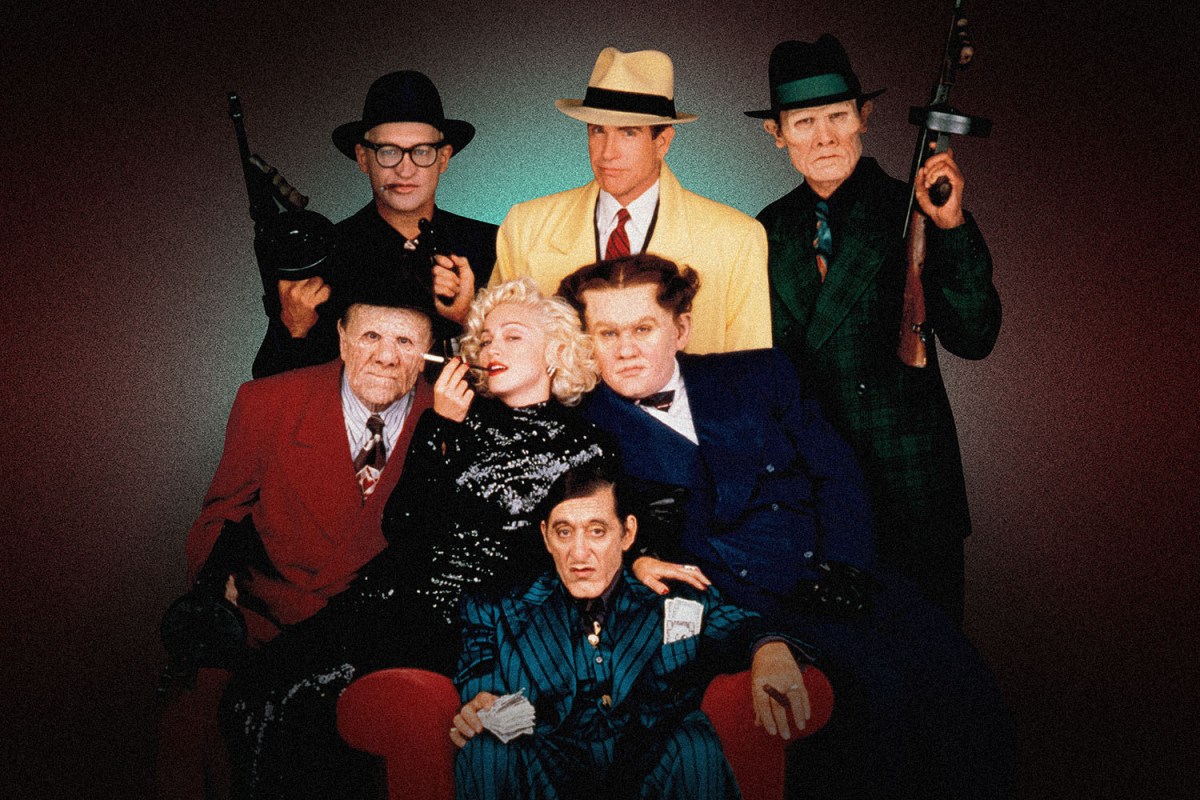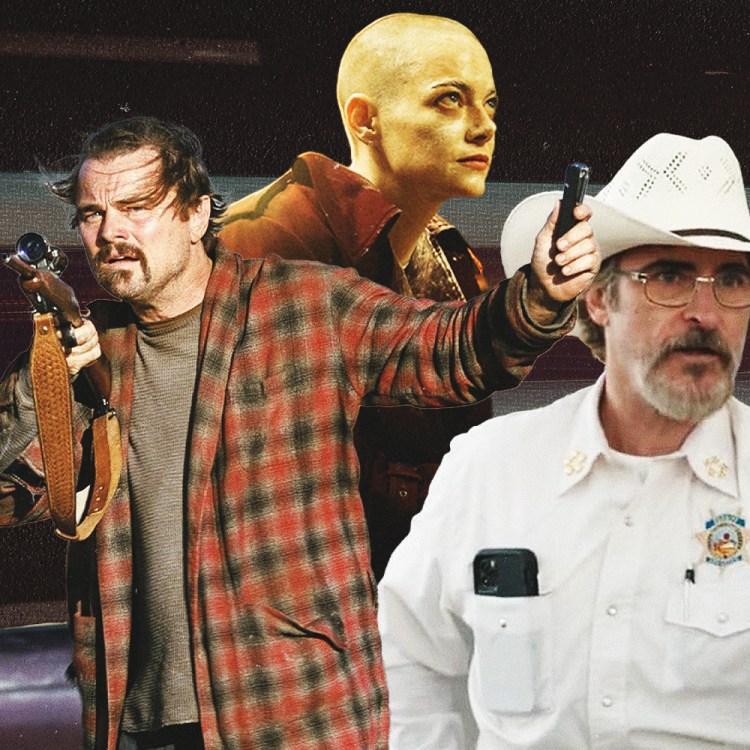Despite what you may have heard, comic-book movies peaked 30 years ago, well before the genre would go on to dominate multiplex screens and cultural conversations.
On June 15, 1990, the third film directed by and starring Warren Beatty (after the 1978 comic fantasy Heaven Can Wait and the 1981 historical epic Reds) was released to much fanfare. Dick Tracy, an adaptation of the hardboiled ’30s comic strip, is a fever dream of a movie packed with New Hollywood stars like Al Pacino, Dustin Hoffman and James Caan hamming it up in front of garish, proudly artificial backdrops. Madonna winkingly sizzles as a femme fatale lounge singer (singing original songs written by Stephen Sondheim and accompanied on piano by Mandy Patinkin, no less) and the film fills out its admittedly thin plot of a good guy fighting bad guys with stylish montages that are equal parts ’30s Hollywood and MTV music video. Watching Dick Tracy today, the film feels more relevant than ever — it stands out as a model of how to make a movie that looks and feels like an old-school comic in all its lurid glory.
The film came just a year after Tim Burton’s blockbuster Batman and shares with it a heightened style, Danny Elfman score and vigorous marketing campaign. In an episode of her podcast You Must Remember This covering the Madonna/Beatty relationship, critic Karina Longworth called Dick Tracy an “even more sophisticatedly designed movie than Batman, and even more surface oriented.” Beatty’s film was hardly just an attempt to cash in on the burgeoning popularity of comic-book movies. The actor/director had been interested in adapting Dick Tracy since 1975, and the property was optioned in 1977. Directors from Martin Scorsese to John Landis to Walter Hill were attached to the film over the years, until Beatty finally bought the rights and decided to directed it in the late ’80s.
Dick Tracy may be Hollywood product (a contemporary cover story in Newsweek proclaimed that everyone knew about the film, “unless you’ve been living in an igloo somewhere near the North Pole, with no access to a satellite dish, a newspaper or a shop that sells $300 Dick Tracy silk pajamas”), but it’s far more aesthetically adventurous than comparable mainstream films today. The film was distributed by Buena Vista Pictures, a division of the Walt Disney Company, with an attendant huge promotional budget and much summer movie hype. There were Dick Tracy McDonald’s toys, cups and scratch-off cards, and even today a search for Dick Tracy merchandise on eBay brings up thousands of results. It’s easy to dismiss a film with this level of marketing as Hollywood at its most corporate, yet the film bears many signs of being a labor of love. In an Entertainment Weekly article Beatty said, “When I realized I was going to direct it myself, I evolved a concept that it could recapture my point of view at the age of six or seven when I was really interested in the strip … Emotionally, I began to get interested in that childlike feeling about the thrill of bright, primary colors, the sight of the stars and the moon, and people with primary emotions.” The kids today might put it more simply: Dick Tracy did not have to go that hard, but it did.

What could have been a vanity project instead became an explosion of creativity. Beatty had a tall order as the director and star. As Newsweek critic David Ansen put it, “Since Tracy was unknown to the prime moviegoing audience, the task was to resurrect him as an entirely new creation, reborn with the profile of Warren Beatty.” Few other actors could’ve pulled off a voluminous yellow Burberry raincoat and matching fedora with such swagger. And while the film was rated PG and had a happy ending, a seedy, old-school vibe pervades the whole affair, with cast members decked out in intentionally grotesque prosthetic makeup that transcends the sanitized stuff that so often gets passed off as family entertainment. It’s a start contrast to comic-book films today: The Marvel and DC universes have their moments of big-screen excitement, but for the most part they stick to a familiar, pseudo-militarized visual code. Dick Tracy, meanwhile, offered up Old Hollywood-inspired flourishes that would be familiar to older audiences, with Beatty shrewdly exaggerating them so much as to make them into something fresh.
The art direction, like the distinctive makeup, won a well-deserved Oscar. In a New York Times article, production designer Richard Sylbert said the original comic strips were “our bible.” The onscreen world is made up of panes of saturated primary colors that recall the limited yet bright palettes of the funny pages, while wipe and iris transitions simultaneously echo literal comic panels and harken back to an earlier era of cinema.
Cinematographer Vittorio Storaro, well known for his sumptuous work with directors like Bernardo Bertolucci and Francis Ford Coppola, made frequent use of split diopter shots which captured the onscreen image with an uncanny level of focus that intentionally messes with our sense of depth. The combination of the colors and camerawork makes for a deliciously unnatural tableau. The film was made entirely on studio lots, and matte paintings of urban nighttime streets were unforgettable backgrounds. In the Times interview, Sylbert called them “completely fake in the best sense of the word.” Were Dick Tracy made today with CGI effects, it wouldn’t have nearly as much pop-art verve.
Costume designer Milena Canonero told Entertainment Weekly that, “Warren was always very concerned that the look not override the story he was trying to tell.” The look does override the story, but it’s a compelling enough look that some viewers and critics forgave the film for not necessarily living up to Beatty’s lofty goals. There are distractions from the story all over Dick Tracy — it feels impossible to watch the film without giving at least a passing thought to the nuances of the short but crucial union between Beatty and Madonna, both figures being so beautiful and representative of particular eras of stardom that they may well seem like comic-book figures even off the screen.
Of course, all the artifice and hype were not without detractors. Washington Post critic Desson Thomson called the film “Tinseltown’s annual celebration of everything that’s wrong with itself: the hype, the agent-negotiated star system, the Hollywood ‘fun’ assembly-line method of copy-cat mediocrity, etc.” Roger Ebert, though, had the opposite reaction, proclaiming the film “a masterpiece of studio artificiality” and praising it for being “sweeter” and “more optimistic” than Batman.
The Hollywood assembly line has only sped up and gotten worse since Thomson’s review. Considering that comic-book adaptations weren’t yet the norm and had more novelty status then, Thomson’s review seems harsh in retrospect. Ebert’s praise of “studio artificiality,” on the other hand, still resonates. It’s telling that there was never a sequel — the world of the film is so highly specific and immersive, and so costly (studio head Jeffrey Katzenberg claimed that Dick Tracy “made demands on our time, talent and treasury that, upon reflection, may not have been worth it,” in a widely circulated memo that was covered in the New York Times) that a Dick Tracy Cinematic Universe was out of the question. Three decades later, it’s hard to picture a major studio bankrolling a film so creative and tailor made to an auteur’s specifications. But the passing of time has proven that Dick Tracy was, in fact, “worth it.” Such colorful imagery and attention to detail in service to a vision of boldly rendered pulp may have been seen as frivolous in its day, but in 2020, Dick Tracy feels like vital cinematic escapism.
This article appeared in an InsideHook newsletter. Sign up for free to get more on travel, wellness, style, drinking, and culture.
























